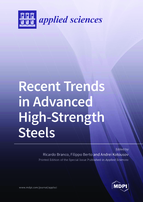Recent Trends in Advanced High-Strength Steels
A special issue of Applied Sciences (ISSN 2076-3417). This special issue belongs to the section "Mechanical Engineering".
Deadline for manuscript submissions: closed (31 December 2019) | Viewed by 51670
Special Issue Editors
Interests: structural integrity; fatigue; fracture mechanics; finite element method; fiber-reinforced composites; environmental effects; additive manufacturing
Special Issues, Collections and Topics in MDPI journals
Interests: fatigue and fracture behavior of materials; mechanical characterization; structural integrity of conventional and innovative materials
Special Issues, Collections and Topics in MDPI journals
Interests: solid mechanics; fracture mechanics
Special Issues, Collections and Topics in MDPI journals
Special Issue Information
Dear Colleagues,
Advanced high-strength steels play an important role in the modern automotive and rail industries because of their balanced properties in terms of strength, fatigue and fracture, wear, machinability, and production costs. In these industries, components are usually subjected to severe service conditions and, therefore, superior mechanical properties are of major engineering significance. Understanding the relationships between the mechanical properties and the chemical composition, microstructural features, and processing techniques is pivotal to develop safe and durable products.
The goal of this Special Issue is to foster the dissemination of the latest research in the field of advanced high-strength steels. Original contributions dealing with the structure characterisation and chemistry analysis; mechanisms involved in microstructure evolution and phase transformation during processing stages; influence of processing techniques and heat treatment routes on structural integrity; or examples of innovative industrial applications of advanced high-strength steels are encouraged. Both experimental and numerical approaches are welcome.
Prof. Dr. Ricardo Branco
Prof. Dr. Filippo Berto
Prof. Dr. Andrei Kotousov
Guest Editors
Manuscript Submission Information
Manuscripts should be submitted online at www.mdpi.com by registering and logging in to this website. Once you are registered, click here to go to the submission form. Manuscripts can be submitted until the deadline. All submissions that pass pre-check are peer-reviewed. Accepted papers will be published continuously in the journal (as soon as accepted) and will be listed together on the special issue website. Research articles, review articles as well as short communications are invited. For planned papers, a title and short abstract (about 100 words) can be sent to the Editorial Office for announcement on this website.
Submitted manuscripts should not have been published previously, nor be under consideration for publication elsewhere (except conference proceedings papers). All manuscripts are thoroughly refereed through a single-blind peer-review process. A guide for authors and other relevant information for submission of manuscripts is available on the Instructions for Authors page. Applied Sciences is an international peer-reviewed open access semimonthly journal published by MDPI.
Please visit the Instructions for Authors page before submitting a manuscript. The Article Processing Charge (APC) for publication in this open access journal is 2400 CHF (Swiss Francs). Submitted papers should be well formatted and use good English. Authors may use MDPI's English editing service prior to publication or during author revisions.
Keywords
- Advanced high-strength steels
- Ultra high-strength steels
- Dual-phase steels
- Complex-phase steels
- Transformation-induced plasticity steels
- Bainitic steels








